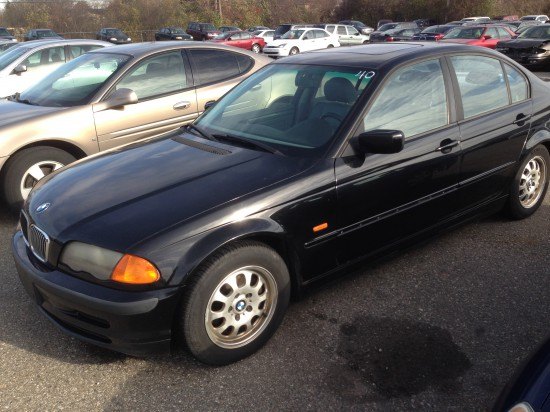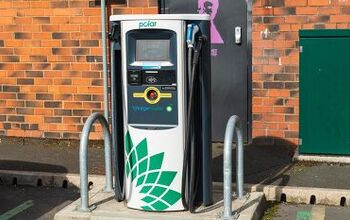Ur-Turn: My BMW Winter Beater
Today’s Ur-Turn comes from TTAC reader Mike Stanizewski, who writes about his experiences with his E46 winter beater. Mike says
“I wanted to write this article after reading some of the recent articles regarding German cars and their long term reliability. Some of the commenters in the Cayenne article were wondering out loud what happens to old German cars when they reach their third uncaring owners. Well here I am, the third uncaring owner, and I want to tell you what it’s like to drive an old, high-mileage German car through the winter months.”
I live in Michigan. In my off hours I buy and sell used cars through my friend’s dealership. This gets me access to used cars at good prices. Every winter I pick out one of these cars to drive during the winter months in order to keep the salt off my nicer car.
I always pick a car that I paid less than $1500 for. This way I keep the cheap one-way insurance on it and feel that my downside risk is pretty low in case of an accident. I try to pick something that’s about 10 years old and around 150,000 miles. Most of the older cars with high mileage are beat, but there are always a few that have been taken care of well. One of these is a great winter beater candidate. In past years I have picked old Focuses as my beater for the winter. If you find a good one, they are reliable rides at least for the four months that I need them to be.
This year, I had already picked out a nice stick shift Focus wagon for myself when I ran across a thing of beauty at the auctions – a nice and shiny BMW 3-series. It has more than 200,000 miles on it but the price was below my $1500 target.
I always had a weak spot for the German cars. I’ve owned several Porsches, BMWs, and Audis over the years. For me, this BMW was a very beautiful car for the price of a Focus. I decided to sell the Focus wagon and keep this BMW. I even joked to my friends that at least if the BMW strands me, I’ll look good standing next to it!
It’s a 1999 BMW 323, the E46 bodystyle. It’s automatic. And it has a few issues. It leaks a little engine oil, power steering oil, and coolant. It has a shake in the center tunnel when starting that is probably the flex coupling to the driveshaft. It has two non-functioning power windows. Sometimes it doesn’t engage reverse gear. The windshield washer pump doesn’t work.
Now you have to have a different mindset for your winter beater than you do with your prized cars. On a car like this, when something breaks or isn’t working to begin with (like the windows), you do a cost-benefit analysis in your head that goes something like “can I live without that feature for four months?” Usually the answer is yes. For something essential like the windshield washer pump, you may have to spend the money to replace it. The plan is to add as little money as possible to this car. For example, I don’t plan to buy any oil for this car. Over the winter I will drive it for about 10,000 miles. The oil that came with it isn’t exactly clean, but it isn’t used up either. I plan to put another 5,000 miles on this oil, and then replace it with some used Mobil 1. The used oil is the oil that I drain from my wife’s minivan after 5,000 miles of use. That oil will stay with the car until I sell it in April, and my oil cost for the beater is zero (I will buy a new oil filter for it though).
I have been driving this car for a month and nearly 2,000 miles now. The car drives very nice. You can feel how wonderful this car must have been when it was new. It has started every day and not let me down so far. I can live with the little leaks and the broken power windows, but I will have to climb under the car and replace that driveshaft coupler before I can sell it since it causes so much shake in the center tunnel. I also have to plan how I park the car, since it sometimes will not engage reverse gear. This is a known problem with a solenoid on the valve body for that particular transmission, but I plan to just live with it and park so that I can always push the car out of its spot in case Reverse is a no go.
I have three months left to go. I am hoping that the car makes the ride.
More by Ur-Turn
Latest Car Reviews
Read moreLatest Product Reviews
Read moreRecent Comments
- Dartdude Having the queen of nothing as the head of Dodge is a recipe for disaster. She hasn't done anything with Chrysler for 4 years, May as well fold up Chrysler and Dodge.
- Pau65792686 I think there is a need for more sedans. Some people would rather drive a car over SUV’s or CUV’s. If Honda and Toyota can do it why not American brands. We need more affordable sedans.
- Tassos Obsolete relic is NOT a used car.It might have attracted some buyers in ITS DAY, 1985, 40 years ago, but NOT today, unless you are a damned fool.
- Stan Reither Jr. Part throttle efficiency was mentioned earlier in a postThis type of reciprocating engine opens the door to achieve(slightly) variable stroke which would provide variable mechanical compression ratio adjustments for high vacuum (light load) or boost(power) conditions IMO
- Joe65688619 Keep in mind some of these suppliers are not just supplying parts, but assembled components (easy example is transmissions). But there are far more, and the more they are electronically connected and integrated with rest of the platform the more complex to design, engineer, and manufacture. Most contract manufacturers don't make a lot of money in the design and engineering space because their customers to that. Commodity components can be sourced anywhere, but there are only a handful of contract manufacturers (usually diversified companies that build all kinds of stuff for other brands) can engineer and build the more complex components, especially with electronics. Every single new car I've purchased in the last few years has had some sort of electronic component issue: Infinti (battery drain caused by software bug and poorly grounded wires), Acura (radio hiss, pops, burps, dash and infotainment screens occasionally throw errors and the ignition must be killed to reboot them, voice nav, whether using the car's system or CarPlay can't seem to make up its mind as to which speakers to use and how loud, even using the same app on the same trip - I almost jumped in my seat once), GMC drivetrain EMF causing a whine in the speakers that even when "off" that phased with engine RPM), Nissan (didn't have issues until 120K miles, but occassionally blew fuses for interior components - likely not a manufacturing defect other than a short developed somewhere, but on a high-mileage car that was mechanically sound was too expensive to fix (a lot of trial and error and tracing connections = labor costs). What I suspect will happen is that only the largest commodity suppliers that can really leverage their supply chain will remain, and for the more complex components (think bumper assemblies or the electronics for them supporting all kinds of sensors) will likley consolidate to a handful of manufacturers who may eventually specialize in what they produce. This is part of the reason why seemingly minor crashes cost so much - an auto brand does nst have the parts on hand to replace an integrated sensor , nor the expertice as they never built them, but bought them). And their suppliers, in attempt to cut costs, build them in way that is cheap to manufacture (not necessarily poorly bulit) but difficult to replace without swapping entire assemblies or units).I've love to see an article on repair costs and how those are impacting insurance rates. You almost need gap insurance now because of how quickly cars depreciate yet remain expensive to fix (orders more to originally build, in some cases). No way I would buy a CyberTruck - don't want one, but if I did, this would stop me. And it's not just EVs.


































Comments
Join the conversation
Rear wheel drive, Michigan winter, and no reverse? No thanks.
E46 automatic, no reverse? http://noreverse.org http://forum.e46fanatics.com/showthread.php?t=706809